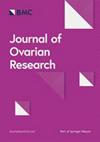NB compounds are potent and efficacious FOXM1 inhibitors in high-grade serous ovarian cancer cells
IF 3.8
3区 医学
Q1 REPRODUCTIVE BIOLOGY
引用次数: 0
Abstract
Genetic studies implicate the oncogenic transcription factor Forkhead Box M1 (FOXM1) as a potential therapeutic target in high-grade serous ovarian cancer (HGSOC). We evaluated the activity of different FOXM1 inhibitors in HGSOC cell models. We treated HGSOC and fallopian tube epithelial (FTE) cells with a panel of previously reported FOXM1 inhibitors. Based on drug potency, efficacy, and selectivity, determined through cell viability assays, we focused on two compounds, NB-73 and NB-115 (NB compounds), for further investigation. NB compounds potently and selectively inhibited FOXM1 with lesser effects on other FOX family members. NB compounds decreased FOXM1 expression via targeting the FOXM1 protein by promoting its proteasome-mediated degradation, and effectively suppressed FOXM1 gene targets at both the protein and mRNA level. At the cellular level, NB compounds promoted apoptotic cell death. Importantly, while inhibition of apoptosis using a pan-caspase inhibitor rescued HGSOC cells from NB compound-induced cell death, it did not rescue FOXM1 protein degradation, supporting that FOXM1 protein loss from NB compound treatment is specific and not a general consequence of cytotoxicity. Drug washout studies indicated that FOXM1 reduction was retained for at least 72 h post-treatment, suggesting that NB compounds exhibit long-lasting effects in HGSOC cells. NB compounds effectively suppressed both two-dimensional and three-dimensional HGSOC cell colony formation at sub-micromolar concentrations. Finally, NB compounds exhibited synergistic activity with carboplatin in HGSOC cells. NB compounds are potent, selective, and efficacious inhibitors of FOXM1 in HGSOC cells and are worthy of further investigation as HGSOC therapeutics.NB 化合物是对高级别浆液性卵巢癌细胞有效的 FOXM1 抑制剂
遗传学研究表明,致癌转录因子叉头盒 M1(FOXM1)是高级别浆液性卵巢癌(HGSOC)的潜在治疗靶点。我们评估了不同 FOXM1 抑制剂在 HGSOC 细胞模型中的活性。我们用一组之前报道过的 FOXM1 抑制剂处理 HGSOC 和输卵管上皮(FTE)细胞。根据通过细胞活力测定确定的药效、有效性和选择性,我们重点对 NB-73 和 NB-115 这两种化合物(NB 化合物)进行了进一步研究。NB 化合物能有效并选择性地抑制 FOXM1,对其他 FOX 家族成员的影响较小。NB 化合物通过靶向 FOXM1 蛋白,促进蛋白酶体介导的降解,从而降低 FOXM1 的表达,并在蛋白和 mRNA 水平上有效抑制 FOXM1 基因靶点。在细胞水平上,NB 化合物促进了细胞凋亡。重要的是,虽然使用泛天冬酶抑制剂抑制细胞凋亡可以挽救 HGSOC 细胞免于 NB 化合物诱导的细胞死亡,但并不能挽救 FOXM1 蛋白降解,这证明了 NB 化合物治疗导致的 FOXM1 蛋白丢失是特异性的,而不是细胞毒性的普遍后果。药物冲洗研究表明,FOXM1 的减少在处理后至少 72 小时内仍然存在,这表明 NB 复合物在 HGSOC 细胞中表现出持久的作用。在亚微摩尔浓度下,NB化合物能有效抑制二维和三维HGSOC细胞集落的形成。最后,NB 化合物与卡铂在 HGSOC 细胞中表现出协同活性。NB 化合物是 HGSOC 细胞中强效、选择性和有效的 FOXM1 抑制剂,值得作为 HGSOC 治疗药物进一步研究。
本文章由计算机程序翻译,如有差异,请以英文原文为准。
求助全文
约1分钟内获得全文
求助全文
来源期刊

Journal of Ovarian Research
REPRODUCTIVE BIOLOGY-
CiteScore
6.20
自引率
2.50%
发文量
125
审稿时长
>12 weeks
期刊介绍:
Journal of Ovarian Research is an open access, peer reviewed, online journal that aims to provide a forum for high-quality basic and clinical research on ovarian function, abnormalities, and cancer. The journal focuses on research that provides new insights into ovarian functions as well as prevention and treatment of diseases afflicting the organ.
Topical areas include, but are not restricted to:
Ovary development, hormone secretion and regulation
Follicle growth and ovulation
Infertility and Polycystic ovarian syndrome
Regulation of pituitary and other biological functions by ovarian hormones
Ovarian cancer, its prevention, diagnosis and treatment
Drug development and screening
Role of stem cells in ovary development and function.
文献相关原料
| 公司名称 | 产品信息 | 采购帮参考价格 |
|---|
 求助内容:
求助内容: 应助结果提醒方式:
应助结果提醒方式:


